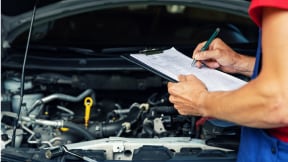What is a powertrain warranty?

“Powertrain” is the collective term for the components of your car responsible for powering and driving the vehicle, including the engine, the driveshafts, the transmission system and the axles. These parts are crucial to your car and expensive to repair, which is why they’re often covered by a specific powertrain warranty. Here’s what to know about what a powertrain warranty is and how it works.
What does a powertrain warranty cover?
Powertrain warranties on new cars are typically offered through the manufacturer. You may also find third-party vendors offering an extended powertrain warranty or warranties on used cars. A powertrain warranty typically covers the entire drivetrain, as well as the engine itself:
- Engine: Of all powertrain components, the engine is possibly the most complex and expensive to repair. Powertrain warranties typically cover all engine parts, such as oil pans, valves, flywheels, belts, gaskets, cylinder blocks and more.
- Transmission: The transmission transfers your engine’s power to the wheels via a complex system of gears, gear trains and belts.
- Driveshaft: The driveshaft is a rod-like part that transfers engine torque from the transmission to the wheels via the axles.
- Axles: An axle is another rod-like part that rotates your wheels.
- Differential: When making a turn or taking a curve, the car’s outside wheels need to rotate faster than the internal wheels to cover more distance in the same amount of time. This is done with the help of a dedicated gearbox called the differential.
- Transfer case: Certain vehicles, such as those with all- or four-wheel drive, use a transfer case between the transmission and the driveshaft.
Note that there are some parts of the powertrain that are classified as wear-and-tear parts that may not be covered by a warranty. These include things like air and oil filters, spark plugs, brake pads and constant velocity (CV) joints. Additionally, things like using unapproved aftermarket modifications, misuse of the vehicle, acts of nature (such as flooding or fire damage) and acts of theft or vandalism may not be covered by a powertrain warranty. There may also be other exceptions specific to your warranty, so it’s best to consult your warranty terms for details.
Types of powertrain warranties
Powertrain warranties can typically be subcategorized into two types: limited or lifetime. Let’s learn a little more about what each of these means:
Limited powertrain warranty
As the name implies, a limited powertrain warranty places limits on the length of time it’s active. This may be a time limit based on years after purchase, a distance limit based on mileage or some combination of both. The manufacturer's powertrain warranty that typically comes with your new car is generally a limited warranty.
Lifetime powertrain warranty
A lifetime powertrain warranty differs from a limited warranty in that it extends for the duration of the purchaser’s ownership. This is typically a separate product from the manufacturer’s limited powertrain warranty. Lifetime warranties also tend to cover fewer parts than a limited warranty.
Powertrain warranty vs. bumper-to-bumper
You may have also heard of another kind of warranty known as the bumper-to-bumper warranty. This typically covers a wide array of things a powertrain warranty doesn’t, but the term “bumper-to-bumper" shouldn’t be taken literally—there are still exceptions. For instance, wear-and-tear items like bulbs, fuses and tires aren't usually covered.
Bumper-to-bumper coverage typically won't cover acts of vandalism or theft, either. (These would be covered under comprehensive insurance policies.) Bumper-to-bumper warranties tend to have shorter terms than a powertrain warranty might. They may have additional limitations as well.
Do I need to get a powertrain warranty?
If you’re buying a new car, your purchase typically already includes a manufacturer’s powertrain warranty. Manufacturers and external vendors may also offer extended warranties. These forms of added coverage are typically a buyer-beware situation, especially if they aren’t from the manufacturer.
If you’re buying a used car, there are some certified pre-owned (CPO) programs that may include an extended powertrain warranty. If you’re not buying CPO, you’ll have to go through third-party sellers, in which case you may need to apply the same buyer-beware rules as above.
Ultimately, a powertrain warranty can provide some financial relief in case something goes wrong with your car’s powertrain. Sadly, the laws of nature dictate that every car’s powertrain will fail at some point. Even more sadly, these repairs are typically quite expensive—possibly even unaffordable without a warranty. In this case, you might consider replacing your car, especially if it’s already seen a lot of miles.
In summary
A powertrain warranty can help provide financial protection for some of the most crucial and expensive equipment on your car. Without warranty coverage, repairs to these parts, like the engine or transmission, could become quite costly. Thankfully, most new cars come with a manufacturer’s limited powertrain warranty. This lasts for either a set number of years or a set number of miles driven. You may also be able to find extended and lifetime powertrain warranties from third-party vendors, but these typically have their own terms and limitations. They may also not always be as reliable as a manufacturer’s warranty, so always read the fine print carefully.



